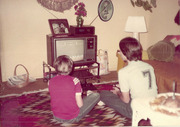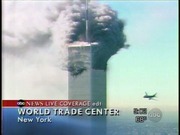tv [untitled] April 14, 2011 8:00am-8:30am PDT
8:00 am
going to recommend that their friends come to san francisco and bring us tourist business? i do not think so. we all know what happened when we had the giants celebration downtown. we had dead zones. people could not call people. what we are talking about here is a very low impact environmentally and architecturally. it is not creating a huge health hazard. it is less than the powers that pg&e is putting out. we need a cohesive signal so that we can show the world that we have an infrastructure to support major events. i say deny the appeal and let the structures go on. >> thank you. next speaker.
8:01 am
>> i live in north beach. i live at exactly 80 feet from where the new tower is going to be installed. thank you for letting me speak tonight, supervisors. i live at 80 feet from the cell tower. my neighbor has never had a problem with her cell coverage. i am here tonight because we all need this tool for our work, for our pleasure. we all need it. i asked you to please have this. we all know that at&t and t- mobile are merging. in less than a year, they will be together. we have to figure route how they
8:02 am
are going to care for this community. it should be a shared responsibility. >> thank you. are there any other members of the public who would wish to speak on behalf of the appellants? i would like to ask the project sponsor if you could step up and do your presentation. >> i am the outside counsel for t-mobile. i would like to refocus this to where we were. the issues regarding need or demand or exceptional circumstances. these are not really relevant to your review this evening. we are talking about whether a categorical exemption is applicable to the planning commission provided to this project. cumulative emf, that is an
8:03 am
issue. this covers the ceqa exemptions. the planning commission took the words right out of my mouth. the fcc standard includes cumulative radio emissions. this concludes that your obligation is to ensure that our operations and the operations of wireless companies in san francisco are compliant with those standards. what you have confirmed that we are in compliance with the fcc standards, it takes it out of your hands and you are done. this is the most progressive in the country in terms of
8:04 am
confirming that we are compliant both individually and cumulatively. before we are able to file for a permit, we must show a study of the existing emf levels. we must provide calculations of the worst case scenarios of the antenna firing at maximum capacity. that is assuming the worst case scenario. the real-life measurements are thousands of times below that. 10 days after it is built, we have to be out there again with meters, showing that it in fact complies. that is not it either. we have to be out there two years later doing the same thing. that is not just us. every cell carrier in san francisco house to provide these
8:05 am
reports every two years. it is thousands of tests a year in san francisco confirming that the emf levels are within this. there is a nice map that shows you that anywhere in north beach that the highest level is 800 times below the federal standard. the concept that this is ignored or has not been reviewed, there needs to be an eir to investigate this is erroneous. one thing that would not be considered in an eir. it has already been addressed by your department. let me jump to ceqa. ceqa says that under the exemption, small structures include three residential
8:06 am
homes, 2500 square feet, four commercial buildings, the environmental impacts that are much greater than the very simple facility. this is 7 feet back from the edge of the roof line. micro cells are allowed if we go through the process. this is provided by the planning director. this particular micro cell runs on two-what radios. -- two-watt radios. this is less than 300 watts. it is a very low -- -- a very low wattage facility. it is no frequency. a small facility and two
8:07 am
antennas instead of nine or 12. berkeley, oakland, san jose are trying to push towards this. san francisco has been doing this for the last 15 years. the appellants are saying that because of cumulative a fax, you should not grant this exemption. i am saying that you should look at all of the antennas that will ever be installed. there were three that were at one time at the planning commission. one of them went through and one of them was continued. this is not a piece meal of one project work every piece is integral to the project. ceqa requires a review of all of the projects. this has a unique coverage area. we need it weather the other sites get the night or not. i am going to turn to the telegraph hill neighbors themselves. we submitted over 600
8:08 am
signatures, letters, and e-mails in support of this facility to provide better service to the community and a couple of our speakers spoke out of turn here. it includes the north beach neighborhood association in support of this facility. this gets support from the jackson square historic association. the tide, i believe, is beginning to turn. these are life-saving devices and are incredibly important. these are integral to our life and our safety. we would be happy to answer any questions that you have. i would like to ask bill, if he is here. he wrote the look on emf and cumulative emf. he would answer any questions
8:09 am
you have about this. please support the very knowledgeable report by the staff and denied the appeal. all of the issues that you heard about, they will be allowed to appeal that to the board of appeals. there is no lack of process in terms of people being able to speak. >> good evening, president, and supervisors. i am a registered professional engineer from the state of california. i want to say that the fcc regulations cover cumulative exposure. that is not one particular frequency, that is the entire frequency band. broadbent needs to be below the limits that are set by the fcc. san francisco has taken a strong
8:10 am
stance on this. a strong stance on enforcement. every application is reviewed by the department of public health. a firm like mine will come out and take measurements of the cumulative levels existing before the facility was built. we calculate what the ad of level would be and add those together. their concern is the cumulative impact. carriers, when they go out and do their own measurements 40 site will measure their own signal to make sure that there signal is adequate. for compliance purposes, it is altogether that are measured. that all goes to the department of public health and is based on that. measurements are done 10 days after a site goes on air.
8:11 am
we have done thousands of measurements of cumulative levels of in san francisco. you saw the back page of the staff report. the measurements are done by the department of health staff. every place in san francisco, the cumulative levels are very, very low. the easily comply with federal safety standards. the issue is cumulative exposure. thank you. >> i want to answer one question. has there been a ceqa appeal in san francisco? there is partly a reason for that. the noticing was not required until the revision in 2007. it has been in the code the last four years. for better or worse, we have been working on the senate leader -- cellular installation
8:12 am
25 years ago. it is not a new site. >> there are a number of questions that folks have. i will start off with one. they laid out the standard that if you have a disfavored site, that you or your client needs to demonstrate that it is essential that you be able to be in that particular place. can you go through that analysis? >> absolutely. she is talking about section 8.1 of the guidelines which was written back in 1996. the excess reuse process, those guidelines are generally dealing with the macro sites that were anticipated in 1996. we did not anticipate this use process, the low wattage come
8:13 am
micro cell sight. -- site. what we have to show is that we have a gap in service. in residential areas, where you do not have commercial locations, we end up in residential areas. we submitted a comprehensive alternative analysis which is required to show all of the six sites that were not available. that was all part of the planning commission review. this was not part of your review in relation to the ceqa analysis. there would not be any additional environmental study regarding the ceqa exemption that would address that issue.
8:14 am
we have addressed that issue. there are maps and drive tests. this is intrusive means for providing service in that area. >> we only have an appeal in regards to that one sight. >> we do not propose a site unless there is a need for it. in most cases, the companies are looking for in building services. we provided that for all three sites. this is the old site that is going forward at this time. they are expensive and it takes a long time. this application was from june,
8:15 am
2009. we are two years into this process. the carriers are suffering. >> the last question i have, the appellants have laid out the maps they have shown of the city and there are a huge proliferation of these micro sites. has there been a discussion of a wave for you and your competitors to design these sites in a way that is a little bit less intrusive and disruptive? >> i hesitate to say that that is what we have been doing for the last 20 years. the guidelines are very robust in terms of establishing design processes. as far as establishing sites that are invisible or close to invisible. that is very true in san
8:16 am
francisco. you see very large facilities with top hats and communication structures on top of office buildings and regular buildings. these have worked very well with the industry to try to do that. the first thing that any carrier looks for is to try to co- locate. the guidelines were set up to direct us to these sites. to the residential zones at the bottom of the list. after 25 years, those are the areas where we can provide service. you are seeing more applications in those areas. in every case, they are looking for other ways to try to provide service that has less impact on the community, but provides the services we are trying to provide.
8:17 am
this places facility is trying to find the right of way. we had to work with the facility that puts it on utility poles. the short answer is that the companies are always looking for them the best and fastest way to install facilities. that is to go through the least review that is possible. that involves having sites that are co-located. the carriers, the information is listed on your web pages. >> thank you. >> thank you. i wanted to thank the planning department and staff for wiping
8:18 am
the legalities and also what is before us. i did want to ask you a question. what i'm grappling with is the appellant's argument that there is a air argument that even the small micro antenna that is being proposed, even smaller wattage than your general bigger antennas, a that cumulatively with the 550 existing cell phone and 10 s and the 350 proposed, why do you need so many antennas? i love the new android phone that i am becoming more dependent on. why do you need so many? i know that at&t has nine proposed. if your service is so good so far, why do you need some money
8:19 am
antennas for the future? it may have a significant environmental impact. >> i apologize for having spent in this business for 25 years. i was young and did not know any better. >> i am young and i am trying to learn more about this and i am concerned about the environmental impacts. >> they thought they could build the area out with 28 cell sites. you could get a mobile phone. there was one site in san francisco. it served 80 phones. you've had to be one of those 80 people that deserve a mobile phone. they could use the same frequency hopping over different cells.
8:20 am
they could take the real-estate and use it over and over again so that more people could have cell phones. we went from those 28 sites up to 900 sites. instead of covering a few miles, it became a few blocks. the power of the antenna can way down. the of our mental impact is theoretically less. you probably remember the old phones. my first one was a briefcase with a handle. the effect of having smaller cell sites with lesser output and phones that have a lesser output by factor of six, you are lessening the impact of the potential results from the ifr. there is probably wifi in this
8:21 am
room. this is probably beyond the original macro cells. this tower has been turned off and taken down. >> the one-mile radius past telegraph hill, there is that same number of 562 wireless sites in los angeles. why do we need so much? i know that it is silly. they seem to mix up cell sites and antennas.
8:22 am
we have tens of thousands of mantegna's. the number of antennas is a funny concept. all that i can say is that each individual site, aunt'does make a difference. it all comes back to the fcc standard and the fact that we are so far below that standard. i think it is 500 and sites in l.a. they are all tall sites that are broadcasting. you could still have lower rf
8:23 am
the missions in that situation then you have with less antennas. there is no direct correlation between the number of antennas and radio frequency emissions. the fact that i have all of these antennas in my pocket it does not mean that i am getting zapped by my phone. each cell site talks to the next site. we have to down tilt the antennas so that each cell site has a coverage area networks within the network. the advantage is reducing the
8:24 am
size, reducing the output, reducing the footprint or the rfr from these. >> i want better service for my cell phone. it seems like a huge concentration in one small area of the city. if there is one area of that will have a significant impact. i am leaning towards that there is that impact. >> i have got to say one more time, you said this in your planning department well. here is your cumulative impact. from every cell carrier that is currently operating in the telegraph hill area. the highest is adjacent to an att site and is 500 times below
8:25 am
the standard. every time one of these goes in, you are re-evaluated again. if you approach the federal standard, you will not be able to succeed. you have every right to deny that next site. i do not know how to better explain that after 25 years, if you believe their number, you are still in the highest area, you are still 800 times below the federal standard on the street. it is angels dancing on the head of a pin. i understand the public concern. people do not understand it. people feel like this will not affect their lives. >> i know that t-moblile -- t-
8:26 am
mobile is not the only ones supporting this. >> i think the planning department 5-year plan goes to the industry that way. >> if i could just follow up the plan, you are saying that because of data at that the department of public health had gathered, it really is not fair from your standard? there is not a fair argument from your perspective? that is your position? >> that is right. there is not a fair argument that there is a cumulative impact from the impairment colfax. it should not be included in your analysis. the federal law does trump ceqa.
8:27 am
it is to provide you with information and facts to make your decision. there have not been any faxed provided by the appellants to suggest that there is a fair argument that has not been considered when granting this categorical exemption. >> thank you. >> the gentleman who was up here earlier who you introduced with regard to this study that was done was that study paid for by your company? >> was it paid for by our company? yes. they are required by the department and i should let him describe this. >> it is an interesting study. >> it is a measurement study that the city requires that the
8:28 am
carriers a met. they hire us to do the study. we submit it to the department of public health. >> separately, the department has done their own studies. is that correct? >> you reference federal government. the federal government has evolves over periods of time, whether through fda or issues related to those that might condone certain uses? in this particular period of time, it seems that maybe this is not a great area, but this is the first time we have seen the conversion of federal thinking catching up with standard of local thinking. articulate concerns of public health, we have seen this over the last 25 years quite rapidly.
8:29 am
i am just wondering why this insistence that because of the fcc standard that this is the golden standard. they're literally is no room for that challenge? >> the federal standard began -- radio waves have been around for a long time. that was reviewed in 1996. it was reviewed in 2007. there are continuing and ongoing studies regarding the radio emissions. this is referred to in your planning and staff reports. this is not an area of the people are ignoring. there is a lot of concern and interest. there continue to be di
64 Views
IN COLLECTIONS
SFGTV: San Francisco Government Television Television Archive
Television Archive  Television Archive News Search Service
Television Archive News Search Service 
Uploaded by TV Archive on

 Live Music Archive
Live Music Archive Librivox Free Audio
Librivox Free Audio Metropolitan Museum
Metropolitan Museum Cleveland Museum of Art
Cleveland Museum of Art Internet Arcade
Internet Arcade Console Living Room
Console Living Room Open Library
Open Library American Libraries
American Libraries TV News
TV News Understanding 9/11
Understanding 9/11




























